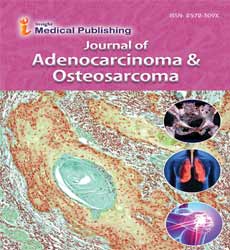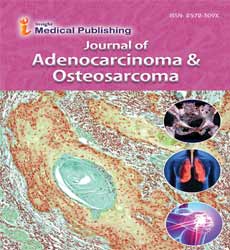Editor Note: Journal of Adenocarcinoma & Osteosarcoma
Guoxiang Xie
Guoxiang Xie*
University of Hawaii Cancer Center, Honolulu, USA
- *Corresponding Author:
- Guoxiang Xie
Assistant Professor in University of Hawaii Cancer Center, Honolulu, USA
Tel: (808) 564-5938
E-mail: gxie@cc.hawaii.edu
Received Date: October 09, 2017; Accepted Date: October 13, 2017; Published Date: October 20, 2017
Citation: Xie G. Editor’s Note. J Adenocarcinoma & Osteosarcoma. 2017, Vol.2 No.1:3. DOI: 10.21767/2572-309X.100017
Copyright: © 2017 Xie G. This is an open-access article distributed under the terms of the Creative Commons Attribution License, which permits unrestricted use, distribution, and reproduction in any medium, provided the original author and source are credited.
Editor’s Note
Cancer or uncontrolled proliferation of cells is the bane of modern life; every year many people succumb to the disease, and the number is only going to increase in the near future. As the root cause of cancer lies at the cellular level, the disease is capable of affecting any of the body tissues. Therefore, studying the mechanisms of cancer and finding innovating novel treatment strategies are of utmost importance. The Journal of Adenocarcinoma & Osteosarcoma makes its own contributions to the field by publishing articles related to mainly two types of cancers: (1) cancer of the mucus-secreting glands (adenocarcinoma), (2) cancer of the bone (osteosarcoma). This journal publishes leading-edge findings in the field, with special focus on the disease pathogenesis, etiology, epidemiology, and underlying mechanisms.
The current issue of the Journal of Adenocarcinoma & Osteosarcoma presents some interesting studies, which can enhance our understanding of the mechanisms underlying cancer, so as to ensure the development of better diagnostic tools and therapies against the disease. Montero et al. [1], investigated crucial reactions in the glycolytic pathway which can be used as targets for developing novel cancer drugs. Singh [2] has dissected the connection between the Epidermal Growth Factor Receptor (EGFR) pathway and autophagy. Boyko et al. [3], investigated the prevalence of esophageal cancer and its spatial distribution in the Nomenclature des Unités Territoriales Statistiques (NUTS) 2 regions of Central and Eastern Europe. Ahmad and Hahn-Stromberg [4] investigated the use of the tumor complexity index as a reliable predictor of cancer prognosis in colon carcinoma. Li [5] investigated the regulation of cell proliferation by reactive nitrogen species (RNS), reactive oxygen species (ROS), and their scavengers. Elsheikh and Zaitoun [6] examined the feasibility of using lymph node sampling in rectal cancer.
Cancer is a condition wherein the normal growth of cells is disrupted, and cells start multiplying in an uncontrolled manner, thereby leading to a malignant state. Many cancerrelated pathways have been used as drug targets for therapeutic purposes; one of these is the glycolytic pathway. Most of the tumor cells exhibit a high glycolytic rate as compared to normal cells. As the glycolytic rate is very high, the pyruvate produced at the end of the glycolytic cycle is transformed into lactate. This metabolic phenomenon makes the tumor more aggressive and robust, resulting in an increase in the intracellular pH and the acidification of the extracellular microenvironment, which contributes to invasion and metastases. Montero et al. [1], therefore thought it pertinent to investigate the most important reactions in the regulation of the glycolytic pathway which can then be used to define novel therapeutic targets.
The role of the (EGFR) signaling pathway in cancer is well documented; mutation or amplifications of EGFR are known to be associated with the majority of cancers. The EGFR pathway has therefore been recognized a promising target for anticancer therapy. However, as the problem of the pleiotropic effects of EGFR activation remains unanswered, certain mechanisms of resistance against anti-EGFR therapy persist in the body. One such mechanism is the role of autophagy in resisting the EGFR therapy. Reports suggest a crosstalk between EGFR and autophagy. For example, some studies suggest that tumors with deregulated EGFR are dependent upon autophagy for their growth and survival; whereas, others suggest that autophagy is promoted upon inhibiting EGFRsignaling. Thus, understanding this nexus between EGFR and autophagy is crucial for the success of any EGFR-based cancer therapy. Singh [2] has reviewed the molecular details of this connection between EGFR and autophagy.
Esophageal cancer ranks sixth among the main causes of cancer-related deaths worldwide. More than 450 000 people have been diagnosed with esophageal cancer, and the incidence of this condition is increasing rapidly. Boyko et al. [3], have investigated the prevalence of esophageal cancer and its spatial distribution in the NUTS 2 regions of Central and Eastern Europe. The authors have estimated esophageal cancer-related mortality rates across these regions using statistical methods. Thus, allowing for a detailed examination of the link between the mortality rates and factors such as: the environmental conditions, local resources, socio-demographic characteristics of the region, the effect of culture and nutrition, the status of the general health of the population, and the status of healthcare in the region.
Tumor growth pattern is known to be associated with cancer prognosis, but the exact details of this connection are not well known. Traditionally, tumors were described using non-standard terms such as central, hilar, deep, or superficial; thus, making comparisons across different case studies impossible. In 2008, a tumor complexity index based on invasiveness was introduced to estimate the grade of tumor complexity; this was termed the tumor complexity index. Ahmad and Hahn-Stromberg [4] analyzed whether the tumor complexity index is a reliable predictor of cancer prognosis in colon carcinoma patients. The authors found that clinicpathological parameters like tumor localization, metastasis, differentiation, and gender were strongly correlated with the tumor complexity index. The authors concluded that the tumor complexity index is associated with tumor differentiation and systemic metastasis in colon carcinoma patients.
The hallmark of any cancer is uncontrolled proliferation of tumor cells due to non-responsiveness to checkpoints signaling cell proliferation inhibition. The underlying mechanisms for this phenomenon are still unclear; mounting evidence suggests that RNS and ROS, generated as a result of chronic inflammation are involved. Therefore, a better understanding how RNS and ROS regulate cell proliferation will aid our understanding of the process of carcinogenesis. Li [5] investigated the regulation of cell proliferation by RNS, ROS, and their scavengers.
In most of the cancers, the status of the lymph node is the strongest predictor of patient outcomes. Many studies have correlated improvement in patient survival with the increased number of retrieved lymph nodes. The total number of lymph nodes (TLNs) retrieved comprises of both positive (PLNs) and negative lymph nodes (NLNs), so the correlation between TLNs and cancer prognosis is skewed. The concept of NLN counts as a prognostic indicator in cancers is gaining momentum, but little is known regarding its prognostic significance. Elsheikh and Zaitoun [6] examined the feasibility of using lymph node sampling in rectal cancer and the effect of treatment modalities and the clinicopathological factors on the total lymph node yield. The authors found that the lymph node number was significantly correlated with the treatment modality, vascular and perineural invasion, and pathological staging.
References
- Montero S, Martin RR, Guerra A, et al. (2016) Cancer Glycolysis I: Entropy Production and Sensitivity Analysis in Stationary State. J Adenocarcinoma 1:2.
- Singh AB (2016) EGFR-Signaling and Autophagy: How they Fit in the Cancer Landscape. J Adenocarcinoma 1:2.
- Boyko V, Dubrovina N, Zamiatin P, et al. (2016) Epidemiology and Forecast of the Prevalence of Esophageal Cancer in the Countries of Central and Eastern Europe. J Adenocarcinoma 1:2.
- Ahmad A, Hahn-Stromberg V (2016) Tumor Growth Pattern is Significantly Associated with Metastasis in Patients Diagnosed with Colon Carcinoma – A Computer Image Analysis Study. J. Adenocarcinoma 1:2.
- Li P (2016) In Vitro Evaluation of Hepg2 Cell Proliferation Altered by Reactive Oxygen and Nitrogen Species. J Adenocarcinoma 1:2.
- Elsheikh S, Zaitoun MA (2016) Factors Influence Lymph Node Retrieval after Resection for Rectal Cancer. J Adenocarcinoma 1:2.

Open Access Journals
- Aquaculture & Veterinary Science
- Chemistry & Chemical Sciences
- Clinical Sciences
- Engineering
- General Science
- Genetics & Molecular Biology
- Health Care & Nursing
- Immunology & Microbiology
- Materials Science
- Mathematics & Physics
- Medical Sciences
- Neurology & Psychiatry
- Oncology & Cancer Science
- Pharmaceutical Sciences
